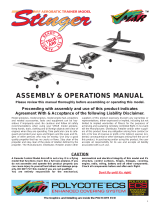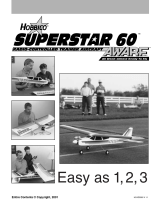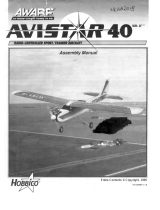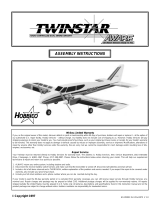Page is loading ...

Stage 1
JOINING THE WING HALVES
To join the wing halves you will need the following items :
2 aluminium wing joiner tubes supplied with kit (dia. 19mm,
900mm length)
One 4-30 machine bolt with 1 butterfly nut
Two 1.5 mm steel washers
Two 2.5 mm wooden washers
2
1.2 Trial fit the aluminium wing joiners
1.4 Pushing slowly the aluminium wing joiner tubes
to the second wing panel and slowly close the gap
TM
1.1 Two aluminium
wing joiner tubes and
wing bolt clam set
Wing joiner slots
Wing bolt clam hole
Center lines
1.3 Push two alu. joiner tubes into the slots of the
first wing pannel all the way to the center lines
Center lines
1.5 Use wing bolt clam set to hold the both wing
panels together
1.6 Cut away wing bolt set
WING ASSEMBLY

Stage 2
Stage 3
3
FITTING AILERON SERVOS
To install the aileron servos into the wing you will need the
following items :
- 2 servos
- Servos mounting screws and grommets as supplied with
servos.
- Servo control arms as supplied with the servos.
- Two aileron control rod assemblies supplied with the kit.
The assemblies consist of a metal rod with a plastic clevis
screwed onto one end.
- Low tack masking tape.
- 2 aileron control horn assemblies
2.1 Prepare the servos by fitting the rubber
grommets & ferrules supplied with your radio
Carefully remove the cover plates from the aileron servo
cavities. Ensure you know which cover plate is for the right
wing and which is for the left. Remove the white cover plates
and retain the mounting screws. Notice that there are wood-
en servo rails pre-installed into each servo cavity end. Locate
the wiring harness tubes that are protruding slightly into
each aileron servo cavity. The tube can be moved slightly at
this point. Check out the other end of each tube for a clean
position and then using C/A glue secure the wiring harness
tubes at the aileron servo cavity end.
Install a servo in each aileron servo cavity and connect the
servo wire to the servo extension wires and run the extension
wires through wiring harness tubes to the centre of the wing
Install the aileron control horns
Aileron servos cavity
2.2 Aileron servos location
2.3 Aileron servos mount 2.4 Srew servo in position 2.5 Install aileron control horn
Step 1 Consult your radio instruction manual and center each aileron servos by plugging it into the aileron channel
in the receiver. Turn on the transmitter and then the receiver. Center the aileron trim lever on the transmitter.
Remove the servo arm mounting screw and the servo arm.
Step 2 Mount the servo arm back on the servo. Position the arm to be parallel with the back edge of the wing. Screw
the arm into place with the servo arm mounting screw supplied with the servo.
Locate the two aileron control rods in the hardware bag. Ensure the clevises are screwed well onto the threaded
portion of the rod. Rotate and tug aggressively on the clevises and ensure that they are not loose on the rods.
Tape the ailerons into their neutral position so that they are even with the trailing edge of the wing and not pointing
either up or down.

Stage 4
4
Step 3 Ensure that the aileron control horns are screwed onto the threaded aileron control horn bolts and that both
control horns are in approximately the same place on their respective bolts.
Step 4 Connect the aileron servo rods to the aileron control horns.The one end with clevis will be attached to the
servo output arm.
Step 5 Connect the other end of the rod to the control horn pre-installed with an EZ connector
Step 6 Remove the masking tape holding the ailerons.
Step 7 In the case of computer radios the servos together by connecting them to the appropiate receiver channel.
In the case of analog radios couple the servos together using a Y harness
Step 8 Turn on your radio and activate the ailerons, using the aileron stick and ensure a smooth full motion can be
achieved.
Step 9 With the wing top side up and viewed from the back, ensure that moving the transmitter aileron stick to the
left raises the left aileron and lowers the right aileron. Movement of the stick to the left will roll the aircraft to the left.
(Counterclockwise roll of the wing when viewed from the back ).
Step 10 With the wing top side up and viewed from the back, ensure that moving the transmitter aileron stick to the
right raises the right aileron and lowers the left aileron. Movement of the stick to the right will roll the aircraft to the
right.
3.1 Aileron control rod assembly 3.2 Aileron control horn assembly 3.3 Aileron control installed
FITTING FLAP SERVOS
To install the aileron servos into the wing you will need
the following items :
- 2 servos
- Servo mounting screws and grommets as supplied
with the servo.
- Servo control arm as supplied with the servo.
- Two flap control rod assemblies
- Low tack masking tape.
4.2 Flap servo location 4.3 Flap servo installed in position 4.4 Final flap instalation
Flap servo location
4.1 Flap control rod assembly

Stage 5
Stage 6
5
4.5 Flap down 4.6 Flap up
FITTING THE HORZONTAL AND VER-
TICAL STABILIZERS
To install the stabilizers to the fuselage you will need.
- Fuselage
- Vertical stabilizer with pre-installed rudder
- Horizontal stabilizer with pre-installed elevator
5.2 The completed fuselage slot should look
like this
Vertical slot
Horizontal slot
5.1 Horizontal stabilizers with pre-installed elevator
5.3 Vertical stabilizers with pre-installed rudder
Check the fit of the horizontal stabilizer
in its slot. Make sure the tail is square
and centred to the fuselage by taking
measurements as shown in the dia-
grams on the right, but don’t glue any-
thing yet.
Equal
distance
Equal distance
900
6.1 Trial fit the horizontal stabilizer in
its slot
FITTING THE HORIZONTAL STABILIZER WITH ELEVATOR

Stage 7
Stage 8
Stage 9
6
With the horizontal stabilizer correct-
ly aligned, mark the shape of the
fuselage on the top and bottom of
the tailplane using a water sol-
ublenon-permanent felt-tip pen as
shown here. 7.1 Mark the top of the horizontal
stabilizer
7.2 Followed by the bottom
Now remove the horizontal stabiliz-
er, using a sharp knife and a ruler
CAREFULLY cut 2mm inside the
marked lines and remove the cover-
ing on the top and bottom of the tail
as shown. Make sure you only cut
the film and not the wood, otherwise
the horizontal stabilizer wiil be
severely weakened.
8.1 Marked lines on horizontal
stab
8.2 Cutting inside the lines
8.3 Removed covering from top
surface
8.4 Exactly the same underneath 8.5 Clean off any traces of pen
Now apply sufficient epoxy to the top and bottom of the
horizontal stabilizer. Use 30 minute epoxy to ensure a
strong bond and give yourself plenty of working time.
Insert the horizontal stabilizer in its slot in the fuselage
and re-check the alignment as in Stage 9. Excess epoxy
should be cleaned off with a rag or tissue before it cures.
9.1 Apply plenty of epoxy 9.2 Slide the horizontal stabilizer
in place
9.3 Wipe off excess epoxy

Stage 10
Stage 11
Stage 12
7
Check the fit of the vertical stabilizer in its slot.
Make sure that it is glued square to the horizon-
tal stabilizer and fuselage
FITTING THE VERTICAL STABILIZER WITH RUDDER
10.1 Trial fit the vertical stabilizer onto fuselage.
11.1 Mark both sides of the verti-
cal stabilizer
11.2 Carefully cut through the
covering
11.3 Remove covering from both
sides
Mark the shape of the fuselage on the left and right
sides of the vertical stabilizer using a felt-tip pen. Now
remove the vertical stabilizer, using a sharp knife &
ruler, CAREFULLY cut just 2mm inside the marked
lines and remove the covering on both sides of the fin,
just as you did with the horizontal stabilizer, making
sure you only press hard enough to cut the covering,
not the vertical stabilizer.
Now apply sufficient epoxy to both sides and the bottom
of the vertical stabilizer. Use 30 minute epoxy to ensure
a strong bond and give yourself plenty of working time.
Insert the vertical stabilizer in its slot in the fuselage
and re-check the alignment. Excess adhesive should
be cleaned off with a rag or tissue before it cures.
12.1 Apply plenty of epoxy 12.2 Slide the fin in place

Stage 13
Stage 14
8
FITTING THE MAIN LANDING GEAR
Identify the main landing gear components shown
below
- 2 main landing gear esemblies
- 2 main wheels ( 60mm x 20mm)
- 1 ABS main landing gear cover (with 6 mounting
screws)
- 4 sheet metal screws 5 x 35 mm with traps
- 2 colars
13.1 Main landing gear components
13.2 Turn over the fuselage to
located the pre-drilled main land-
ing gear mounting holes
13.3 Use 4 sheet metal screws and
2 traps to mount the main landing
gear onto the fuselage
13.4 Pilot drill mounting holes
with 1/16 (or 1,6 mm) drill-bit
13.5 Mount the main landing gear
fairing with 2x10 screw
13.6 Install the wheel 13.7 Install the main landing gear
cover
FITTING THE TAIL WHEEL
14.1 Insert the tail wheel steering
wire into the steering guide tube
14.2 Screw the tail wheel assem-
bly to the fuselage
14.3 Trim off the excess tail steer-
ing wire
Install the tail wheel assembly. Note that the tail wheel
assembly has a loose wire end. Slide the loose wire
end into the sleeve tube that has been installed into
bottom of the rudder. Position the plastic bracket on
the bottom of the fuselage. Mark the location of the
screw holes. Tap the holes with the screws and then
fasten the plastic bracket to the fuselage. See the
illustration below.

Stage 15
Stage 16
9
FITTING THE FUEL TANK
To assemble the fuel tank you will need the following
items:
- The fuel tank and fuel stopper assembly (supplied)
- The clunk (supplied)
- About 7” (20 cm) of medium ID silicone fuel line (DUB
197 or similar)
- Cross head Philips screw driver
15.1 Use 100 mm (4 in) for fuel line
and 50 mm (2 in) for pressure line
15.2 Illustration of fuel line posi-
tioning inside the tank
15.3 Fuel tank installed on the
power module
100 mm (4 in) for fuel line
50 mm (2 in) for pressure line
fuel line
pressure line
INSTALLING THE ENGINE
The engine and the fuel tank are installed onto the
power module. First remove the power module from
the fuselage by removing the 4 nuts & washers
16.1 Aluminum engine mount 16.2 Power module assembly 16.3 Engine thrust line
Fuel tank
holder dowel Engine thrust line
16.4 Engine and engine mount
recommentdation orientation.
16.5 Engine and fuel tank posi-
tioned on the power module
16.6 Throttle control connection
to the engine

Stage 17
Stage 18
10
16.7 Cowl installation 16.8 Install the muffer and con-
nect the fuel and pressure line
16.9 Install the suitable prop and
spinner
FITTING ELEVATOR AND RUDDER CONTROL HORN
The elevator control is fitted on the underside of both right and left
of the elevator halves. Pierce the covering over the pre-drilled hole
for the control horns installation as shown.
17.2 Elevator control horn location 17.3 Rudder control
horns location
17.4 Elevator and rudder control
horn connected to the contrrol rod
17.1 Control horn assembly
Elevator control horn location
INSTALLING THE SERVOS
Install the rubber servo grommets and brass ferrules supplied with your radio
equipment. The three servos that control the elevator and rudder are
Installed in the servo tray mounted in the fuselage. Remove servo tray from
the fuselage, mounting the servos to the servo tray as shown. 18.1 Universal servo mount
18.2 Servo tray located under the seats. Remove
the seats to install servos
18.3 Pre-installed push rods on the fuselage
Unscrew
Rudder pushrod
Pilot stick con-
trol pushrod
Elevator pushrod

Stage 19
Stage 20
Stage 21
Stage 22
11
19.1 Consult the picture showing how the rudder and ele-
vator servos are positioned and connected to the
pushrods.
CONNECTING THE PUSHRODS TO THE THROTTLE, RUDDER AND ELEVATOR SERVOS
Connect the elevator servo to the
receiver and turn on your transmitter.
Confirm that the neutral positions of
the elevator servo are sustained
CONNECTING THE PUSHRODS TO THE ELEVATOR
20.1 Two independent elevator
control horns shown in position
20.2 Connecting the elevator
pushrods to the control horns
CONNECTING THE PUSHRODS TO THE RUDDER
Connect the rudder servo to the
receiver and turn on your transmit-
ter. Confirm that the neutral posi-
tions of the rudder servo are sus-
tained as per illustration 22.4
21.1 Connecting the rudder pushrod to the rudder control
horn
Elevator servos
Rudder servo
Stick control rods
CONNECTING THE THROTTLE CONTROL
Connect the clevis to the engine throttle arm at roughly
half throttle. Look into the throat of the engine carburettor
as you rotage the throttle arm and select a position where
the throttle opening is about hafl what it is when fully
open.
engine throttle arm
22.1 Throttle control rod con-
nected to the engine throttle arm

Stage 23
Stage 24
12
Adjust the deflection of the control surfaces to match the specifications on page 15
You can reduce the amount of throw by doing either or both of the following:
- From the servo end, move the clevis or EZ connector to a hole in the servo arm that is closer to the servo output
shaft.
- From the control horn end, move the horn out further on the threaded bolts. Always confirm that the horn is still
thoroughly engaged with the threaded bolt after you have adjusted it.
ADJUST CONTROL SURFACE THROW LIMITS.
Before starting the final
set-up of the model,
switch on the radio and
ensure that all trims are
in their neutral posi-
tions. Check that the
ailerons, elevator and
rudder are centred. If
any adjustments are
needed, do these by
uncoupling the relevant
clevis and turning it
clockwise to shorten the
linkage or couter -
clockwise to lenthen it.
Only when each control
surface has been cen-
tred mechanically in this
way should you begin
adjusting the surface
movement (or throw)
FINAL R/C SET-UP
ELEVATOR
UP
ELEVATOR
DOWN
AILERON
UP
AILERON
DOWN
AILERON
DOWN
AILERON
UP
RUDDER
RIGHT
RUDDER
LEFT
Now confirm
that the con-
trol surfaces
are moving in
the correct
direction. Use
the servo
reversing
swiches on
your transmit-
ter to reverse
the direction
of a servo if
necessary.
The most
popular
transmitter
mode (with
the throttle on
the left, with
ailerons and
elevator on
the right) is
shown here.
Stage 25

26.1 Consult your radio manual for instructions
about hooking up your receiver battery, receiver and switch harness.
26.2 Wrap the battery pack securely in foam suitable for RC equipment and wrap the foam insulated pack in a plas-
tic bag or cling wrap.
26.3 Thread the battery pack connector back through from beneath the fuel tank to the radio compartment by pass-
ing the battery connector through an opening beside the fuel tank.
26.4 Connect the battery connector to your radio system according to the radio manual.
27.1 Consult your radio manual for instructions about hooking up your receiver.
27.2 Plan where you are going to put the receiver with consideration for routing the antenna safely.
27.3 Wrap the receiver securely in foam suitable for RC equipment and wrap the foam insulated receiver in a plas-
tic bag or cling wrap.
27.4 Generally in the absence of specific instructions from the radio manufacturer, it is recommended that the
receiver should be placed where it is least likely to have impact during a crash. Keep the battery pack and other
heavy loose items ahead of the receiver.
28.1 Consult your radio manual for instructions about testing and operating your radio system.
28.2 Pay particular attention to charging your radio system batteries and range testing the system before and after
each flight.
28.3 Check that all controls are working correctly before and after each flight.
The CG for your DO 27 is located at 95 to 100 mm (3.3/4 to 4 inch ) back from the leading edge of the wing when
the wing has been attached to the fuselage.
For the initial flight, the CG should be located at 3”3/4 (95mm) back from the leading edge of the wing when
the wing has been attached to the fuselage.
The CG is measured with the engine, radio gear and all other components installed but WITH NO FUEL IN THE
TANK.
Set up the CG as it will be when you fly it BUT WITH NO FUEL IN THE TANK.
It is very important to have the CG correct. Flying your model with the CG too far will likely lead to loss control and
a crash.
If you discover that after you have assembled your model and installed your radio and engine that the CG is incor-
rect you must bring the CG to the correct location by doing the following BEFORE FLYING :
- Move the battery pack fore or aft.
- Move other components fore or aft.
- Change engine to a lighter or heavier model.
- Add weight to the nose or tail. If adding it to the nose, try to make it useful by going to a heavier duty engine
or adding a spinner with a heavy metal backing plate. As a last resort, add stick on “dead” weight where appro-
priate.
13
INSTALLING THE RECEIVER BATTERY
Stage 26
Stage 27 INSTALLING THE RECEIVER
Stage 28 COMFIRM RADIO OPERATION
Stage 29 BALANCING THE AIRCRAFT.

NOTE : The throws are measured at the widest part of the elevator, rudder and aileron. Adjust the position of the
pushrods at the control/servo horns to control the amount of throw. You may also use the ATV’s if your transmitter
has them but the mechanical linkages should still be set so that the ATV’s are near 100% for best servo resolution.
High rate Low rate
ELEVATOR 3/4 “ ( 19mm) up 1/2” (12.5mm) up
3/4 “ ( 19mm) down 1/2” (12.5mm) down
RUDDER 1“1/5(30mm) right 3/4” (19mm) right
1”1/5(30mm) left 3/4” (19mm) left
AILERON 5/8” (14mm) up 1/2” (12.5mm) up
5/8” (14mm) down 1/2” (12.5mm) down.
Note: If your radio does not have dual rates, then set the control surfaces to move al the low rate throws.
14
30.1 Once you have confirmed that the CG is
correct, you should do a thorough review of the
entire model before your first flight. Check every-
thing twice! Every hook up, every coupling, every-
thing! Do it twice!!
30.2 Before your first flight , have an experienced
flyer review your work. Do not fly your model until
it has been checked out by a third party who
knows how to fly and how to set up a model air-
craft
30.3 Once you have completed your first flight,
get in the habit of checking your model over
before and after each flight! Don’t fly if you find
something that is not right!
Stage 30 CONFIRM MECHANICAL INTEGRITY
Elevator Aileron Rudder
3/4”
19mm
1/2”
12.5mm
CG
Parts for this VMAR Model
In the event that you require replacement parts for you VMAR DO 27 - 120 PIRELLI, you can order parts from your retailer or from
the VMAR On - line store at www.richmondrc.com.
Fuselage #VA.104H.1202F (with servo tray & all rods)
Wing set #VA.104H.1202W (a set of left and right with joiner ect)
Tail set #VA.104H.1202T (contains horizontal and vertical stabilizers)
Cowl #VA.104H.1202L (fiberglass)
Canopy set #VA.104H.1202N (canopy and frame)
Main gear #VA.104H.1202MG (fiberglass main landing gear with axle set)
Wheel pant set #VA.104H.1202WH (with main gear fairing set)
Covering set #VA.104H.1202V (POLYCOTE ECS)
Wing parts bag #VA.104H.1202WP (spar joiner, aileron rods ect)
Master bag #VA.104H.1202MB (as in kit)
For aftermarket parts and other information related to this model see VMAR On - line at
www.richmondrc.com.
95 - 100 mm
33/4 - 4”
1/2”
12.5mm
1/2”
12.5mm
1/2”
12.5mm
3/4”
19mm

15
Your VMAR DORNIER DO 27 Model is covered in POLYCOTE ECS.
The new ULTRA TOUGH POLYESTER covering from VMAR !
WHAT’S IT ALL ABOUT ?
POLYCOTE ECS is an Enhanced Covering System Engineered in
Canada and Available only from VMAR. With POLYCOTE ECS the
graphics are inside the covering... not stuck on top. No Decals! No
Layers! No Strips! No Stripes! VMAR Models using POLYCOTE
ECS have very few seams and our proprietary SURE SEAL system
ensures that the seams stay down! Best of all, POLYCOTE itself is
a totally fuel proof ULTRA TOUGH POLYESTER
For more information, Please visit our website:
www.richmondrc.com/support.htm
DORNIER DO 27
TM
TM
/






